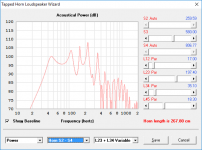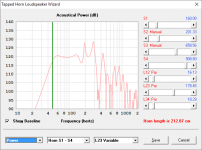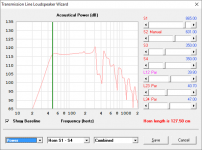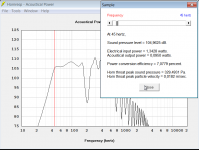At this point I assume you already have the LAB12  Check out Brian Steele's POC3. Works well with LAB12 and on the smaller side of things. The Subwoofer DIY Page v1.1 - Projects : "Proof of Concept #3" FWIW pretty anything I've simmed with LAB12 and LAB15 is saddle shaped.
Check out Brian Steele's POC3. Works well with LAB12 and on the smaller side of things. The Subwoofer DIY Page v1.1 - Projects : "Proof of Concept #3" FWIW pretty anything I've simmed with LAB12 and LAB15 is saddle shaped.
All this being said, I think the THAM12 is clearly the winner of DIY high output with compact design.
All this being said, I think the THAM12 is clearly the winner of DIY high output with compact design.
At this point I assume you already have the LAB12Check out Brian Steele's POC3. Works well with LAB12 and on the smaller side of things. The Subwoofer DIY Page v1.1 - Projects : "Proof of Concept #3" FWIW pretty anything I've simmed with LAB12 and LAB15 is saddle shaped.
Um...
I don't think the LAB12 is a good match for pro audio THs. It might work, but there are better 12" matches out there for similar price. Like the Eminence Kappalite 12" driver, for example.
Attachments
At this point I assume you already have the LAB12Check out Brian Steele's POC3. Works well with LAB12 and on the smaller side of things. The Subwoofer DIY Page v1.1 - Projects : "Proof of Concept #3" FWIW pretty anything I've simmed with LAB12 and LAB15 is saddle shaped.
All this being said, I think the THAM12 is clearly the winner of DIY high output with compact design.
No I haven't bought yet, I list liked the PAL12, it uses the LAB12 which is in my budget, but the PAL12 is a little too tall. Always open to suggestions. I will have a look at Brian's design over the weekend. The application is small venue portable PA. DJ style, either rock or trance which I know have different low end requirements. I come from a large W bin/scoop 10ton PA background, so all the small subs like tapped horns are new to me.
Last edited:
Sorry for the thread revival.
I am looking at buying 2 THAM12's and am stuck deciding between these two drivers:
Faital Pro 12FH500 and the Beyam 12P80fe
They retail for practically the same price locally. These will be in my room, I am most concern about fidelity, finesse and a flatter response as opposed to weight and how it handles various weather conditions.
I still need to learn hornresp and am currently therefore unable to model the Beyma myself and cannot find any sims of the Ferrite version.
Any assistance will be greatly appreciated!
I am looking at buying 2 THAM12's and am stuck deciding between these two drivers:
Faital Pro 12FH500 and the Beyam 12P80fe
They retail for practically the same price locally. These will be in my room, I am most concern about fidelity, finesse and a flatter response as opposed to weight and how it handles various weather conditions.
I still need to learn hornresp and am currently therefore unable to model the Beyma myself and cannot find any sims of the Ferrite version.
Any assistance will be greatly appreciated!
IMO, the THAM12 is not for home use, unless you happen to need ridiculously high efficiency for some reason. The LF extension is easily beaten by a long-throw driver in a ported box of the same size, and both will go loud enough for most people in a domestic environment.
What the THAM12 does well is go quite loud for a fairly small box. You've got solid extension to 50Hz, which is plenty of kick for a portable disco or live band.
Chris
What the THAM12 does well is go quite loud for a fairly small box. You've got solid extension to 50Hz, which is plenty of kick for a portable disco or live band.
Chris
IMO, the THAM12 is not for home use, unless you happen to need ridiculously high efficiency for some reason. The LF extension is easily beaten by a long-throw driver in a ported box of the same size, and both will go loud enough for most people in a domestic environment.
What the THAM12 does well is go quite loud for a fairly small box. You've got solid extension to 50Hz, which is plenty of kick for a portable disco or live band.
Chris
What I am looking for in a sub is that "live band" experience and I would like a very "tactile" subwoofer.
I currently have a 12" in a large 120L ported enclosure, tuned low. It is great for HT and such but does not offer what I am looking for.
I have had a listen to a few other "standard efficiency" subwoofer builds, they all seem to lack that tactile experience.
They are indeed not meant for home use, that is to say you could use them in that fashion, but it was not the intended user case.
Going strictly on T/S (so simulation) between these two my vote is for the Beyma, the reasons are :
Slightly higher MMS, the only hint we have to indicate a tougher cone.
Higher BL - this is never wrong.
Lower QTS (0,185!) - this is also never wrong.
Please note that neither of these will hold up to serious abuse in a TH, both of their cones are to weak judging by MMS, but for home use i assume they can work, treat them nicely and they provide a nice experience in return, again, I have not made any simulation comparisons.
Going strictly on T/S (so simulation) between these two my vote is for the Beyma, the reasons are :
Slightly higher MMS, the only hint we have to indicate a tougher cone.
Higher BL - this is never wrong.
Lower QTS (0,185!) - this is also never wrong.
Please note that neither of these will hold up to serious abuse in a TH, both of their cones are to weak judging by MMS, but for home use i assume they can work, treat them nicely and they provide a nice experience in return, again, I have not made any simulation comparisons.
What I am looking for in a sub is that "live band" experience and I would like a very "tactile" subwoofer.
I currently have a 12" in a large 120L ported enclosure, tuned low. It is great for HT and such but does not offer what I am looking for.
I have had a listen to a few other "standard efficiency" subwoofer builds, they all seem to lack that tactile experience.
Look very carefully at your integration between the sub and the rest of the speakers and/or room. My bet is you've got a dip in the response that's robbing you of some "feel".
Chris
I know what you mean, but I lack the knowledge to explain it, it is one of the most common comments for all the TH's I have built, surface mounted designs does not couple to the air in the same way is my guess.I have had a listen to a few other "standard efficiency" subwoofer builds, they all seem to lack that tactile experience.
For kicks, I compared the Beyma driver (featured on your site, the Beyma12LX60V2) loaded in a THAM12 (some minor corrections made to your model, e.g. the use of PAR segments and cone compensation) to one loaded in my POC6 build, which is an offset-MLTL. The THAM12 is tuned slightly higher (about 1 Hz higher) and the box is a bit bigger (95 l net vs. 64 l net). The THAM 12 seems to be a good 3dB more sensitive through its passband, but output at 40 Hz is about the same (suggesting a steeper rolloff) and of course everything goes crazy above about 150 Hz while the POC6 is flat up to about 300 Hz.
The designs look comparable on paper, but what Hornresp does not show is that the THAM12 likely suffers from very little vent compression at the lower end of the passband, while I've measured up to 2dB at Fb. Sometimes the sims don't show you everything .
.
The designs look comparable on paper, but what Hornresp does not show is that the THAM12 likely suffers from very little vent compression at the lower end of the passband, while I've measured up to 2dB at Fb. Sometimes the sims don't show you everything
Attachments
I would like a very "tactile" subwoofer
Our ROAR series is the most tactile and punchy bass-bin I have heard to date.
I use a ROAR12 under my computer and workplace table, and it can really deliver a physical short sharp knock when called upon. Computer games and EDM is lots of fun, but I can never turn up the volume as much as I want to as everything starts to rattle and buzz.
I drive my ROAR12 with the inbuilt plateamp in my cheap 2.1 Logitech computer sound system.
With a Powersoft K10 it can make a whole 300 m2 industrial warehouse kind of building rattle and buzz with ease.
It is a comparably cheap B&C 12PS100 and the box is built using only straight cuts and rectangular pieces.
Martinsson's Blog
Regards,
Johannes
For kicks, I compared...
Brian, to me that was one of those great posts (#35), by example you are highlighting both the pros and cons of two designs in a very fair and balanced way, and you add the very important aspect of interpretation of the result given how different principles work in a very good way, great post, good example, thank you.
Last edited:
Brian, to me that was one of those great posts (#35), by example you are highlighting both the pros and cons of two designs in a very fair and balanced way, and you add the very important aspect of interpretation of the result given how different principles work in a very good way, great post, good example, thank you.
Thanks Martinsson.
I had another look at the comparison, using REW and data about the two designs exported from Hornresp, and came up with the following:
Image 1 - this shows a direct comparison between the THAM12 and the POC6. Below 50 Hz, the responses are pretty close, but it must be said that's below the passband for both designs. Above that, the THAM12 is about 2.5dB more efficient, for about 1/3rd increase in box size. The illustrated response curve for the POC6 is a bit rougher than expected because the Hornresp export does not include the impact of the stuffing at the start of the line, which with smooth the response above 100 Hz. There will be no "blip" in the response of the POC6 just below 200 Hz.
Image 2 - Phase response of the THAM12. It goes through a 180 degree phase shift from 48.1 Hz to 110.2 Hz, and again between 110.2 Hz and 184.9 Hz. Note that the lowest resonance frequency is at 48.1 Hz (0 degrees).
Image 3 - Phase response of the POC6. It goes through a 180 degree phase shift from 48.7 Hz to 227 Hz, less severe than the THAM12, and there's only 60 degrees of phase shift between 100 Hz and 200 Hz, compared to over three times that for the THAM12. Theoretically that should make integration with a "top" speaker a bit easier, but that's theoretically.
Image 4 - What if you stack these two boxes side by side and play them together? Well, this would be the result. It doesn't actually look too bad below 120 Hz, so maybe THs and vented/MLTL alignments can play nice together for bass reproduction.
Image 5 - GD for the THAM12. Up to ~140 Hz, it actually seems to be better than the POC6, particular when you consider the delta GD is about 13.5 ms.
Image 6 - GD for the POC6. A bit worse than the THAM12 across the passband. the audibility of GD at these low levels is somewhat debatable however.
From the results, one could say that the THAM12 is larger and a bit less easy to integrate into a system, but will require just a little more than 1/2 the power to achieve the same SPL levels as the POC6 within its passband. At higher SPL levels the difference in output will be greater around 50 Hz and below. The POC6 however is smaller and a bit easier to carry (because of its form factor).
One last one...
Image 7 - the responses of the POC6 and THAM 12 at the same passband level (the response of the POC6 adjusted 2.5db upwards). The POC6 exhibits 2dB more output at 50 Hz, but that will disappear at higher levels due to vent compression.
Attachments
-
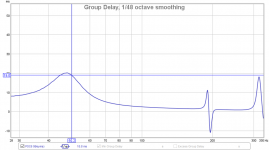 20180119-POC6 vs THAM12 (6).png44.7 KB · Views: 77
20180119-POC6 vs THAM12 (6).png44.7 KB · Views: 77 -
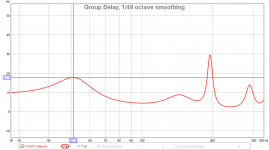 20180119-POC6 vs THAM12 (5).png41.5 KB · Views: 77
20180119-POC6 vs THAM12 (5).png41.5 KB · Views: 77 -
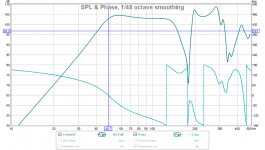 20180119-POC6 vs THAM12 (4).png88.5 KB · Views: 83
20180119-POC6 vs THAM12 (4).png88.5 KB · Views: 83 -
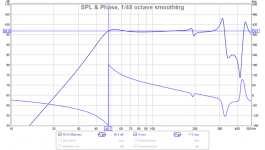 20180119-POC6 vs THAM12 (3).png73.1 KB · Views: 443
20180119-POC6 vs THAM12 (3).png73.1 KB · Views: 443 -
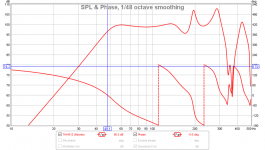 20180119-POC6 vs THAM12 (2).png78.5 KB · Views: 461
20180119-POC6 vs THAM12 (2).png78.5 KB · Views: 461 -
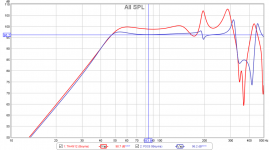 20180119-POC6 vs THAM12 (1).png69.1 KB · Views: 480
20180119-POC6 vs THAM12 (1).png69.1 KB · Views: 480 -
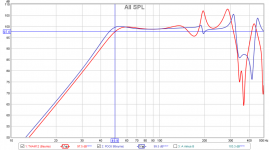 20180119-POC6 vs THAM12 (7).png71.1 KB · Views: 107
20180119-POC6 vs THAM12 (7).png71.1 KB · Views: 107
They are indeed not meant for home use, that is to say you could use them in that fashion, but it was not the intended user case.
Going strictly on T/S (so simulation) between these two my vote is for the Beyma, the reasons are :
Slightly higher MMS, the only hint we have to indicate a tougher cone.
Higher BL - this is never wrong.
Lower QTS (0,185!) - this is also never wrong.
Please note that neither of these will hold up to serious abuse in a TH, both of their cones are to weak judging by MMS, but for home use i assume they can work, treat them nicely and they provide a nice experience in return, again, I have not made any simulation comparisons.
Thanks Martinsson,
I do not play to abuse them and doubt I will ever need to put high amounts of power through them so I feel as if I can get away with a lighter / weaker cone.
I was leaning towards the Beyma as I am considering some Beyma mids (possibly even the 12p80nd) at a later point for a new speaker build - but that is still a while away. I imagine it will make it easier to integrate the two together.
Our ROAR series is the most tactile and punchy bass-bin I have heard to date.
I use a ROAR12 under my computer and workplace table, and it can really deliver a physical short sharp knock when called upon. Computer games and EDM is lots of fun, but I can never turn up the volume as much as I want to as everything starts to rattle and buzz.
I drive my ROAR12 with the inbuilt plateamp in my cheap 2.1 Logitech computer sound system.
With a Powersoft K10 it can make a whole 300 m2 industrial warehouse kind of building rattle and buzz with ease.
It is a comparably cheap B&C 12PS100 and the box is built using only straight cuts and rectangular pieces.
Martinsson's Blog
Regards,
Johannes
Hi Johannes,
I was originally considering this actually, I spoke to Anders about it. His recommendation was the THAM12 over the ROAR12, he felt the ROAR12 more suited to a professional environment and obviously he has had far more listening hours with the THAM12 over the ROAR12. The THAM12 is still very new and looks very promising in terms of exceeding the THAM12 design.
With regards to fidelity, definition and such I am not sure how the ROAR12 compares to the THAM12. I suspect them to be quite similar? I have heard people mention the ROAR12 to be extremely tactile and punchy - another reason Martinsson recommended the THAM12 over it, as the ROAR12 is not very neighbor friendly.
A big positive for the THAM12 is the size, far smaller than the ROAR12 and with home use in mind this helps with regards to the WAF.
What are your opinions and experience with regards to the ROAR12 vs the THAM12?
- Status
- This old topic is closed. If you want to reopen this topic, contact a moderator using the "Report Post" button.
- Home
- Loudspeakers
- Subwoofers
- THAM12 - a compact 12" TH
